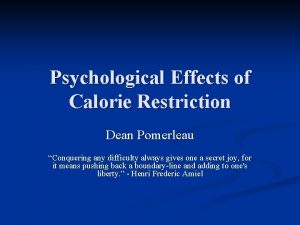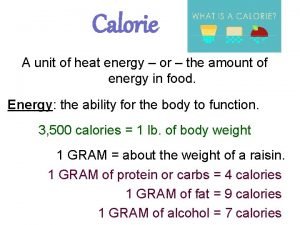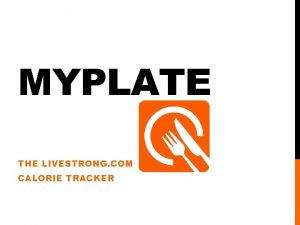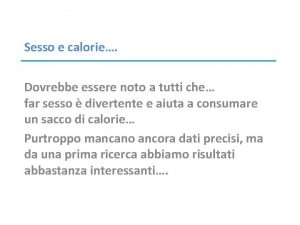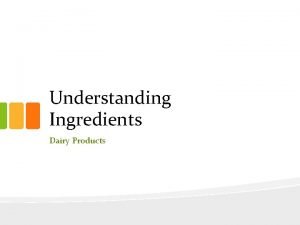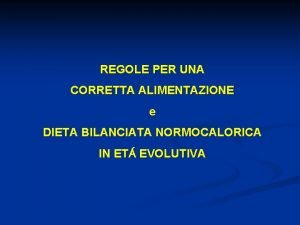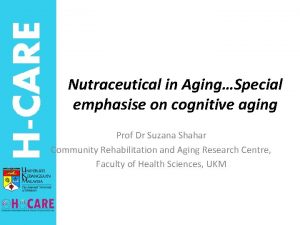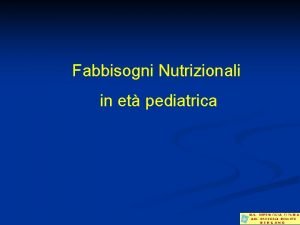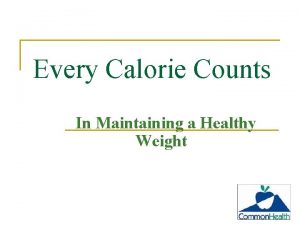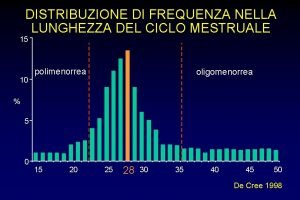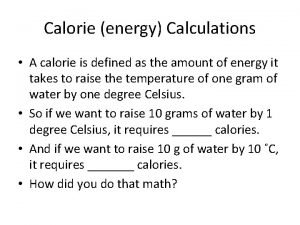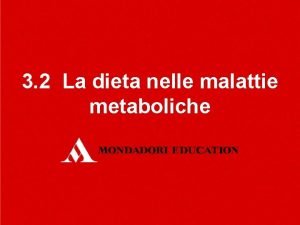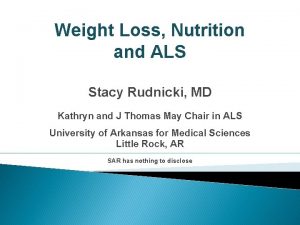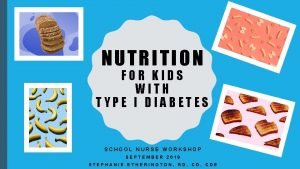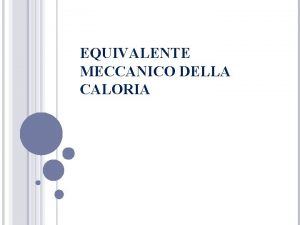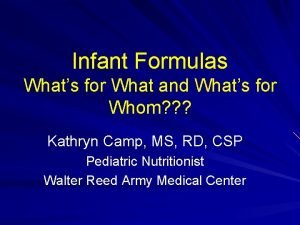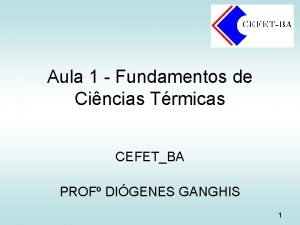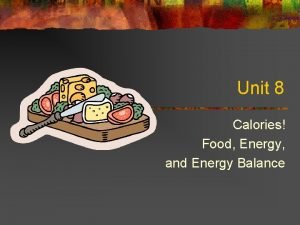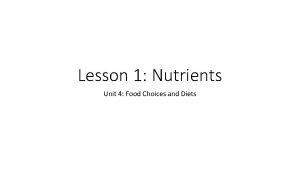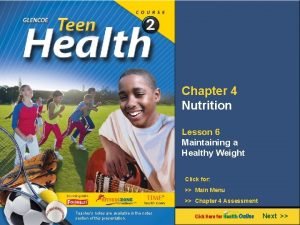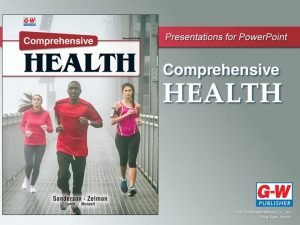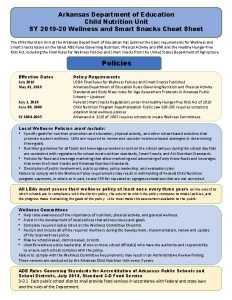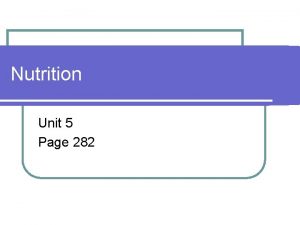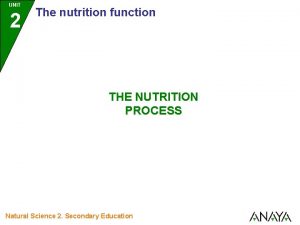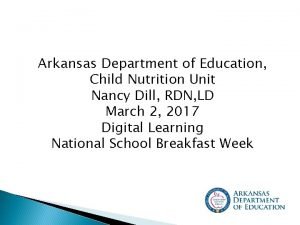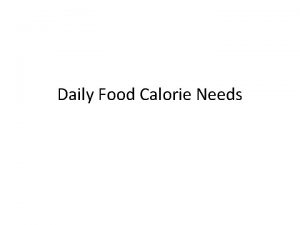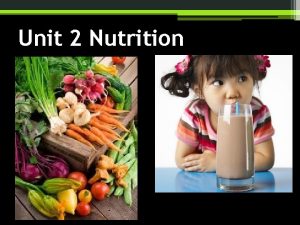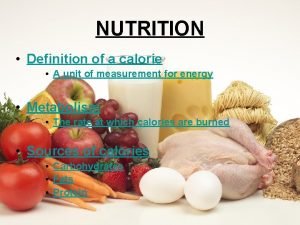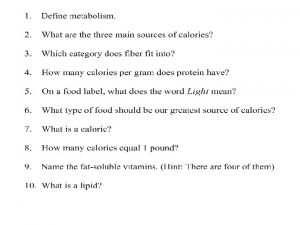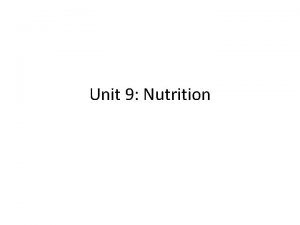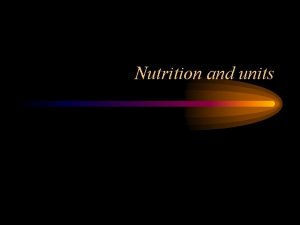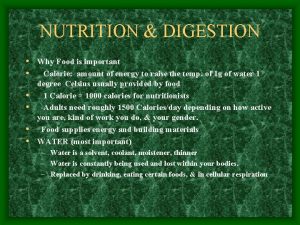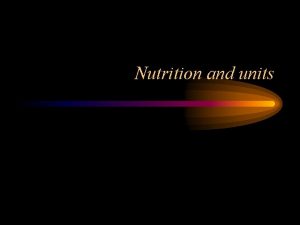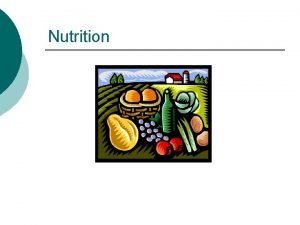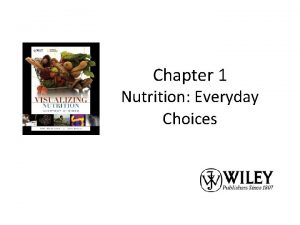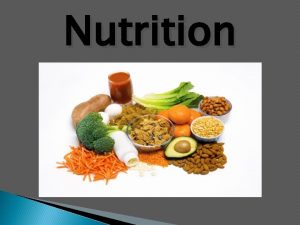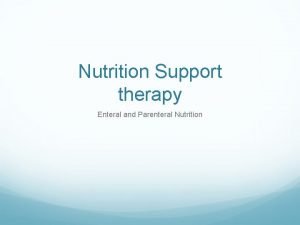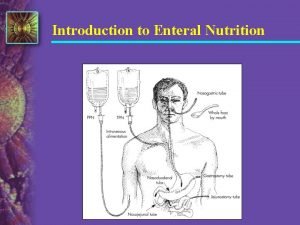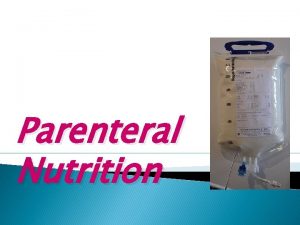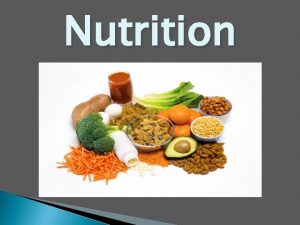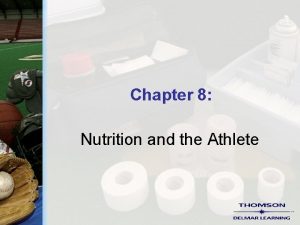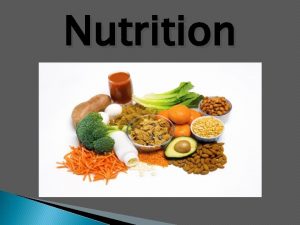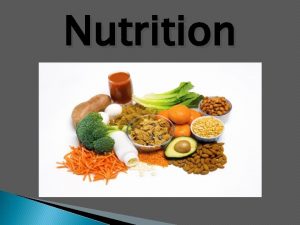NUTRITION Definition of a calorie A unit of
































- Slides: 32


NUTRITION • Definition of a calorie • A unit of measurement for energy • Metabolism • The rate at which calories are burned • Sources of calories • Carbohydrates • Fats • Protein

METABOLISM • The rate at which calories are burned. • Basal Metabolic Rate BMR



Six Nutrients • • • Carbohydrates Fats Proteins Vitamins Minerals Water

9 8 7 6 5 Calories / gram 4 3 2 1 0 Carbs Fat Protein

CARBOHYDRATES • Carbohydrates are the • • body’s preferred source of energy. Simple and Complex 45 -65% of daily calories should come from carbohydrates, most of which should be complex Protein 15% Fat 30% Carbs 55% Carbs Fat Protein

Simple Carbohydrates • • Sucrose (table sugar) Fructose (Fruit) Lactose (Milk) Maltose (Grain) • Simple carbohydrates are like putting paper on a fire

Sources of Carbohydrates • Simple – Natural sugars • Fruits, veggies, milk, etc – Processed sugars • Table sugar, molasses, syrups, etc. • Complex – Pasta – Seeds – Legumes • Peas, beans, & potatoes – Vegetables – Fruits – Fiber ** Complex carbohydrates are like putting kindling on a fire

Benefits of FIBER -tough, stringy part of vegetables, fruits, and grains • Cannot be digested • Helps move waste through digestive • • • system Helps prevent constipation, appendicitis, and other intestinal problems Helps prevent various types of cancer Bulky foods; feeling of fullness, longer to chew

SOURCES OF FIBER • • Fruits and vegetables (especially the skin) Pasta Beans Brown rice Oatmeal Popcorn Corn tortillas 25 – 35 Grams per day

Total fiber (grams)* 8. 0 Fruits Serving size Raspberries 1 cup Pear, with skin 1 medium 5. 5 Apple, with skin 1 medium 4. 4 Banana 1 medium 3. 1 Orange 1 medium 3. 1 Strawberries (halves) 1 cup 3. 0 Figs, dried 2 medium 1. 6 Raisins 1 ounce (60 raisins) 1. 0

Grains, cereal & pasta Total fiber Serving size (grams)* Spaghetti, whole-wheat, cooked 1 cup 6. 3 Barley, pearled, cooked 1 cup 6. 0 Bran flakes 3/4 cup 5. 3 Oat bran muffin 1 medium 5. 2 Oatmeal, instant, cooked 1 cup 4. 0 Popcorn, air-popped 3 cups 3. 5 Brown rice, cooked 1 cup 3. 5 Bread, rye 1 slice 1. 9 Bread, whole-wheat or multigrain 1 slice 1. 9

Split peas, cooked 1 cup Total fiber (grams)* 16. 3 Lentils, cooked 1 cup 15. 6 Black beans, cooked 1 cup 15. 0 Legumes, nuts and seeds Serving size Lima beans, cooked 1 cup Baked beans, vegetarian, canned, 1 cup cooked Sunflower seed kernels 1/4 cup 13. 2 10. 4 3. 9 Almonds 1 ounce (23 nuts) 3. 5 Pistachio nuts 1 ounce (49 nuts) 2. 9 Pecans 1 ounce (19 halves) 2. 7

Total fiber (grams)* Vegetables Serving size Artichoke, cooked 1 medium 10. 3 Green peas, cooked 1 cup 8. 8 Broccoli, boiled 1 cup 5. 1 Turnip greens, boiled 1 cup 5. 0 Brussels sprouts, cooked 1 cup 4. 1 Sweet corn, cooked 1 cup 4. 0 Potato, with skin, baked 1 small 3. 0 Tomato paste 1/4 cup 2. 7 Carrot, raw 1 medium 1. 7

Agree or Disagree • Fat tastes good. • Being obese is worse than being overweight. • If we don’t eat fat, we won’t get fat.

FATS -Scientific name is lipid: fatty substance that does not dissolve in water • Saturated – Mainly animal sources – Solid or semisolid at room temperature • Unsaturated – Mainly vegetable sources – Liquid or oil at room temperature *** < 30 % of your calories should come from fat

Protein 15% Fat 30% Carbs 55%

Sources of Fat • Visible fat – Butter, margarine, vegetable oil, fat layer on meat and poultry • Hidden fats – Marbled in meat, chocolate, seeds, egg yolk, ice cream, cheese, cream soups, doughnuts • Food preparation – Frying and cooking with sauces

Roles of Fat • Absorb and transport fat-soluble vitamins • • • A, D, E, & K Maintains the health of skin & hair Adds flavor Protects vital organs Insulates your body Form of stored energy Helps to satisfy hunger

Trans Fats • Formed by a process called hydrogenation – Basically taking unsaturated fat and making it saturated – Causes the oil to harden • Initially created to increase shelf life of many common food items – Cookies, crackers, & other baked goods • Usually less expensive than using saturated animal fats • What to beware of – partially hydrogenated


PROTEINS • Vital part of every cell – Muscle, bone, teeth, skin, & blood all contain protein – “life could not exist” • Made of amino acids – – – • 20 different amino acids Your body can make 11 of the 20 “Essential amino acids” are the 9 your body cannot make • You must get them through your diet 10 -15 % of calories should come from protein

Protein 15% Fat 30% Carbs 55%

Roles of Protein • To build and maintain all body tissues • To regulate many body processes • • (hormones) To identify and destroy bacteria and viruses (antibodies) Source of energy, however this takes away from its intended roles

Sources of Protein • Animal sources – – – – Fish Beef Poultry Eggs Milk Cheese Yogurt • Complete proteins because they contain the essential amino acids • Plant sources – – Legumes Seeds Nuts Grains • Incomplete proteins because no single plant protein has all the essential amino acids in adequate amount – Exception = SOY

Vitamins • Water Soluble – Dissolve in water & easily pass into the bloodstream during digestion – Body doesn’t store – Excess removed by the kidneys and passed in urine • Fat Soluble – Stored in body fat for later use – Could become toxic, although it is rare – Seldom needed as a supplement – A, D, E, K

Minerals ** Elements in food used by the body • Magnesium – Muscle and nerve function – Aids energy production • Calcium – Promotes bone health – Reduces risk of osteoporosis – Ages of 10 -20 key to building bone mass


WATER • Moves food through digestive system • Helps digest carbs & protein • Transports nutrients and removes wastes • Aids in storing and releasing heat • Helps to cool the body through perspiration • Cushions eyes, brain, & spinal cord • Lubricates joints

WATER cont. • Aids other chemical reactions in the body • 20% of intake comes from food • If you wait until thirsty, you’re already dehydrated • Caffeine is a diuretic – makes you pee!
 Dean pomerleau
Dean pomerleau Différence entre calorie et kilocalorie
Différence entre calorie et kilocalorie How much protein is 3 oz of chicken
How much protein is 3 oz of chicken Livestrong daily plate
Livestrong daily plate Dragibus calories
Dragibus calories Calorie sesso
Calorie sesso Tiramisu light calorie
Tiramisu light calorie Grammature dieta
Grammature dieta Calorie restriction
Calorie restriction Noci calorie
Noci calorie Equazione di schofield
Equazione di schofield Superfoods
Superfoods Fsh alto
Fsh alto Calcolo fabbisogno calorico giornaliero
Calcolo fabbisogno calorico giornaliero Calorie is defined as
Calorie is defined as Perdite di sangue in menopausa
Perdite di sangue in menopausa Harris-benedict -basal metabolic rate calorie calc
Harris-benedict -basal metabolic rate calorie calc Food exchange chart
Food exchange chart Equivalente meccanico del calore
Equivalente meccanico del calore Enfamil ar 22 calorie formula recipe
Enfamil ar 22 calorie formula recipe Endotermico
Endotermico Unit 10, unit 10 review tests, unit 10 general test
Unit 10, unit 10 review tests, unit 10 general test Biobeyond unit 8 nutrition lab counting calories
Biobeyond unit 8 nutrition lab counting calories Food and nutrition unit 4
Food and nutrition unit 4 Rda food label
Rda food label Unit 3 nutrition lesson 6 anorexia nervosa and bulimia
Unit 3 nutrition lesson 6 anorexia nervosa and bulimia Chapter 4 body weight and composition answer key
Chapter 4 body weight and composition answer key Arkansas child nutrition unit
Arkansas child nutrition unit Unit 26 self evaluation answers
Unit 26 self evaluation answers Food and nutrition unit 5
Food and nutrition unit 5 Autotrophic plants examples with names
Autotrophic plants examples with names Child nutrition unit arkansas
Child nutrition unit arkansas Unit 26 animal anatomy physiology and nutrition
Unit 26 animal anatomy physiology and nutrition
